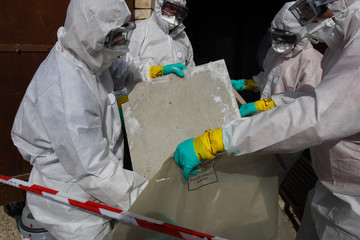In New Zealand, Asbestos has become a source of health anxiety for homeowners due to its past use as a popular building material. Despite being concealed in plain sight, asbestos is prevalent in older homes and commonly found within tiles. It’s essential to identify these harmful tiles because they pose serious risks to residential safety and well-being. This article intends on offering you an informative visual guide that will assist you in identifying “how does Asbestos look like NZ” and provide guidance on managing it inside your home.
What is Asbestos?

Asbestos is a set of six naturally occurring fibrous minerals with thin, needle-like fibers that are known for their strength and heat resistance. As such, it was commonly utilized in building materials as an insulator and fire retardant. To ensure safety measures against potential health hazards, homeowners in New Zealand must be able to identify asbestos within their homes.
The History of Asbestos in New Zealand Homes
In New Zealand, asbestos was a common building material that held a significant place in construction from the 1940s until the mid-1980s due to its impressive resilience and fireproof characteristics. To gain insight into this substance’s prevalence within Kiwi homes and detect materials containing asbestos with accuracy, it is crucial to explore its employment history comprehensively.
During its heyday in New Zealand, asbestos was frequently used as a component in various residential building materials. Some of the key applications included:
- Roofing: Roofing in New Zealand was commonly done using asbestos cement sheets, which had excellent durability against the adverse weather conditions. These rugged roofing materials ensured efficient protection against atmospheric effects.
- Siding: Asbestos was a preferred option for builders and homeowners as it provided insulation and fire resistance to homes when utilized in siding materials.
- Tiles: Asbestos tiles were widely chosen for flooring purposes due to their cost-effectiveness and strong built. With the availability of different hues and designs, homeowners could personalize their living spaces as desired.
Identifying Asbestos Tiles in New Zealand
Determining whether your tiles contain asbestos is a crucial concern for both homeowners and contractors. To help identify the potential presence of this hazardous material, here are key indicators to keep in mind:
| Criteria | Details |
| Visual Characteristics | These tiles are commonly 9″x9″ or 12″x12″ and have a grainy texture that resembles sand or grains. They come in various textures, colors, and patterns which can make it difficult to identify them without multiple cues. |
| Age of the Building | Asbestos tiles are more common in houses that were built or renovated before the 1990s, as construction usage decreased from the mid-1980s onwards and is less likely to be found in newer buildings. |
| Backing Material | Many times, tiles are equipped with a black or dark background material to act as an indicator. Although not all tiles that have a dark backing contain asbestos, it is still an important feature when evaluating them. |
| Professional Inspection | It is recommended to seek professional help for conclusive identification. Certified assessors are capable of performing inspections, gathering samples for laboratory examination and providing precise outcomes. Self-testing should be avoided as hazardous fibers may potentially become airborne during the process. |
Health Risks of Asbestos

The inhalation of asbestos fibers can lead to severe and often fatal diseases. Understanding these conditions is critical for appreciating the seriousness of asbestos exposure:
- Lung Cancer: Prolonged exposure to asbestos fibers significantly increases the risk of developing lung cancer, a potentially deadly disease characterized by uncontrolled cell growth in lung tissue.
- Asbestosis: This condition involves scarring of the lung tissue, resulting from the body’s reaction to inhaled asbestos fibers. Asbestosis can severely impair lung function and is irreversible.
- Mesothelioma: Particularly associated with asbestos exposure, mesothelioma is a rare and aggressive form of cancer affecting the lining of the lungs, abdomen, or heart. It is almost exclusively caused by asbestos exposure and has a poor prognosis.
For homeowners in New Zealand, recognizing these risks and understanding “what does asbestos look like NZ” is essential for early detection and prevention of exposure.
Comprehensive Identification of Asbestos in Residential Settings
To effectively manage the risk of asbestos, homeowners should be familiar with its appearance and common locations within the home:
- Detailed Appearance Characteristics: Asbestos was used in various products, including insulation, roofing, tiles, and even textiles. It doesn’t have a distinctive look when mixed with other materials, making it challenging to identify without professional help.
- Texture and Consistency: Asbestos materials may present as crumbling, old insulation, or as robust and intact floor tiles. The texture can range from smooth to rough, depending on the product’s condition and the type of asbestos used.
- Variety of Colors and Patterns: Asbestos-containing materials come in an array of colors and patterns, especially in vinyl tiles and roofing shingles, masking its presence to the untrained eye.
If you’re concerned about any material in your home, avoid disturbing it and note its characteristics, location, and condition for a professional evaluation.
In-Depth Guide on What to Do If You Suspect Asbestos
Upon suspecting the presence of asbestos:
- Avoid Disturbance: Keep away from the suspected area. Disturbing asbestos-containing materials can release fibers into the air, increasing the risk of inhalation.
- Seek Professional Testing: To safely prove the presence of asbestos, a licensed asbestos removalist or tester can take samples and do tests.
- Discuss Removal or Encapsulation: If asbestos is present, a licensed professional can guide you through the safest approach for removal or encapsulation, ensuring that fibers are not released during the process.
Enhanced Preventative Measures for Asbestos Exposure
Proactive measures are vital in managing the risks associated with asbestos:
- Conduct Regular Inspections: Look for signs of wear or damage in materials known to contain asbestos. Early detection can prevent the release of fibers.
- Expand Your Awareness: Continually educate yourself about “what does asbestos look like NZ” and stay updated on the best practices for handling and living with asbestos materials in your home.
Conclusion
Understanding “what does asbestos look like NZ” is crucial for maintaining a safe living environment. If you suspect your home may contain asbestos tiles, take immediate steps to confirm their presence and seek professional guidance for removal or management. With the right knowledge and resources, you can effectively address asbestos concerns and ensure the safety and well-being of everyone in your home.
Remember, while this guide provides valuable information, it is always recommended to consult with professionals for asbestos testing and removal in your specific situation. Stay informed, vigilant, and proactive in managing asbestos within your home.
FAQs
How can I tell if my tiles contain asbestos?
Look for size, texture, and the age of your home. Professional testing is the only way to confirm the presence of asbestos.
What does asbestos look like NZ in tiles specifically?
In NZ, asbestos tiles can be various colors and patterns, often with a gritty texture and usually in sizes of 9″x9″ or 12″x12″.
Is it safe to live in a house with asbestos tiles?
If the asbestos-containing materials are in good condition and undisturbed, they may not pose an immediate risk. It’s essential to monitor their condition and consult professionals.
Can I remove asbestos tiles myself?
It is strongly advised against due to the health risks involved. Always consult a licensed professional for removal or encapsulation.
What are the laws regarding asbestos in New Zealand?
New Zealand has specific regulations for the management and removal of asbestos. Familiarize yourself with the WorkSafe NZ guidelines.




